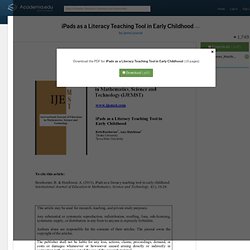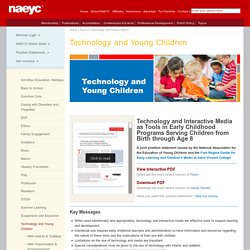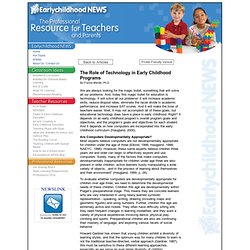

iPads as a Literacy Teaching Tool in Early Childhood. IJEMST (International Journal of Education in Mathematics, Science and Technology) & Teale, 1986).

Young children are strategic literacy learners who pay attention to the print world, participate inthat world, and develop theories about how that world works (Gillen & Hall, 2003). As children explore their literate environment, they develop the understanding that written language makes sense, or what Goodman(1986) calls the roots of literacy. Goodman (1986) defines these roots as: (1) the development of print awarenessin situational contexts- this root refers to the knowledge young children gain about the print in their environment. When children understand the print in their environment, they use the print, along with other cueing systems, to make sense of print; (2) print awareness in connected discourse- children develop awarenessof print in connected discourse based on the types of written language, such as books, magazines, or letters, theyencounter.
Writing. Each source show evidence of technology has a. Gurnee School District 56. Warren-Newport Public Library: The Warren-Newport Public Library District provides the community with access to information, kindles the imagination of children and adults, and supports lifelong learning. TechInPrimaryClassrooms. Evidence of ismart technology being a positive. Both websites agree that technology is a. Technology and Young Children. Key Messages When used intentionally and appropriately, technology and interactive media are effective tools to support learning and development.

Intentional use requires early childhood teachers and administrators to have information and resources regarding the nature of these tools and the implications of their use with children. Limitations on the use of technology and media are important. Special considerations must be given to the use of technology with infants and toddlers. Attention to digital citizenship and equitable access is essential. View Key Messages Summary (PDF) Examples of Effective Practice View Examples of Effective Practice (PDF) Technology That Supports Early Learning Pre-recorded Webcast: Technology and Interactive Media as Tools in Early Childhood Programs This prerecorded 21-minute webcast addresses key messages in the position statement.
View the webcast. Earlychildhood NEWS - Article Reading Center. We are always looking for the magic bullet, something that will solve all our problems.

And, today this magic bullet for education is technology. It will solve all our problems! It will increase academic skills, reduce dropout rates, eliminate the racial divide in academic performance, and increase SAT scores. And it will make the lives of teachers easier. Well, it may not accomplish all of these goals, but educational technology does have a place in early childhood. Are Computers Developmentally Appropriate? To evaluate whether computers are developmentally appropriate for children over age three, we need to determine the developmental needs of these children. Howard Gardner has shown that young children exhibit a diversity of learning styles, and that the optimum way for many children to learn is not the traditional teacher-directed, verbal approach (, 1987). 1. 2. 3. Integrating technology in every day learning (positive) Infants_toddler_ipads_Head_to_Toe_slides. Using Technology in the Early Childhood Classroom.
By Kimberly Moore Kneas, Ph.D. and Bruce D.

Perry, M.D., Ph.D. Early Childhood Today: Are young children's brains (ages three through six) well suited to the use of technology? (We define technology as children using cameras, computers, tape recorders and video cameras in classroom projects.) If so, how? Are some forms of technology better than others for these specific age levels? Dr. I see technology doing the same things today. Modern technologies are very powerful because they rely on one of the most powerful genetic biases we do have — the preference for visually presented information. The problem with this is that many of the modern technologies are very passive. Sitting young children in front of a television for hours also prevents that child from having hours of other developmental experiences. On the other hand there are many positive qualities to modern technologies. Dr. Back to top Dr. I think that balance and timing are the keys to healthy development. Technologies should be used to enhance. Does Technology Have a Place in the Early Childhood Education (ECE) Classroom?
Technology.

Electronic media. Early childhood. Literacy. Are these four concepts mutually exclusive, or do they hold the potential to interact and promote deeper connections in the education of young children? Will the use of technology and media support the developmental needs of young children, or do these tools take away from essential developmental needs and experiences? The National Association for the Education of Young Children, in conjunction with the Fred Rogers Center for Early Learning and Children’s Media at Saint Vincent College, Pennsylvania are currently working on a revised position statement, Technology in Early Childhood Programs Serving Children from Birth through Age 8, which will be published in spring 2012.
So when it comes to technology and electronic media what is developmentally appropriate for young children? At all ages, but especially under the age of two, it’s important to determine whether technology is supplementing or taking away from something.